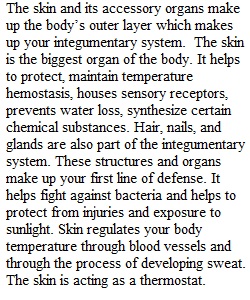


Q Module 3Lab: Structures and Functions of the Integumentary System The skin is made up of two main layers: the epidermis and the dermis. Within the epidermis, there are 5 layers of epithelial tissue. The dermis is composed of two layers of connective tissue and contains other structures such as glands, blood vessels, hair follicles and nail beds. This lab will explore the structures and functions of the dermal and epidermal layers. Create a Table: Use the information from your textbook, Connect and other sources to create a table of information about the integumentary system. Use the following headers: Skin Layer, Structural Features, and Functions. Under each header, note the skin layer name, describe the histological appearance including the cell types, include the fiber types for the dermal layers, and summarize each layer’s functions. Create a Report or Presentation: Use the following format to review what you learned in a report or presentation. Introductory Paragraph: Start with a broad discussion of the integumentary system. Why is this organ system important? How does it help the body maintain homeostasis? Results/Data: Insert the table here. Discussion: Discuss each of the following topics: • Compare and contrast the different layers of the epidermis and dermis based on their histological features and functions. How is the function of the epidermis different than the dermis, for example? Within the epidermis, how is each layer adapted to serve its function? • Describe the structure and function of accessory structures to the integumentary system: gland, hair and nails. • How does the skin help maintain body temperature? • What are the immunological functions of the skin? Conclusion: End with a section describing what was particularly interesting to you in this lab. Requirements: Create a paper or presentation. Paper: • Your paper should be 3-4 pages long, in addition to the required cover page and reference pages. Include at least one scholarly reference, in addition to the course textbook. The following link to the CSU Global Writing Center provides more information on how to find scholarly sources. • Conform to the APA guidelines in the CSU Global Writing Center. • The CSU Global Library is a good place to find these references. Presentation: • Consult the CSU Global guidelines for producing a visual presentation prior to working on this assignment. • Develop an 8-10 slide presentation, not including the title and reference pages, which are required. • Your presentation MUST either include your script notes containing 80-100 words per slide.. • Include at least one scholarly reference, in addition to the course textbook. The following link to the CSU Global Writing Center provides more information on how to find scholarly sources. • Conform to the APA guidelines in the CSU Global Writing Center. • The CSU Global Library is a good place to find these references. If you create your presentation using Prezi, SlideShare, or some other web-based presentation tool, you will need to copy the link to your presentation with script notes and paste it into a Word document with a brief note to your instructor regarding the link and any special instructions for viewing your project once opened. Rubric BIO200 Mod 3 Lab BIO200 Mod 3 Lab Criteria Ratings Pts This criterion is linked to a Learning OutcomeFormal Lab Report 25 to >20.0 pts Meets Expectation Demonstrates strong or adequate knowledge of the materials; correctly represents an understanding of the lab process and results. All of the following elements (equipment, procedure, creation of table, requirements) are represented thoroughly. 20 to >15.0 pts Approaches Expectation Some significant, but not major, errors or omissions in demonstration of knowledge. All of the following elements (equipment, procedure, creation of table, requirements) are represented, although not thoroughly or completely. 15 to >10.0 pts Below Expectation Major errors or omissions in demonstration of knowledge. Some of the following elements (equipment, procedure, creation of table, requirements) are represented, although not thoroughly or completely. 10 to >0 pts Limited Evidence Fails to demonstrate knowledge of the materials. None of the following elements (equipment, procedure, creation of table, requirements) are represented thoroughly. 25 pts This criterion is linked to a Learning OutcomeDemonstrates college-level proficiency in organization, grammar, and style. 10 to >8.0 pts Meets Expectation Project is clearly organized, well written, and in proper format as outlined in the assignment. Strong sentence and paragraph structure; few errors in grammar and spelling. 8 to >6.0 pts Approaches Expectation Project is fairly well organized and written, and is in proper format as outlined in the assignment. Reasonably good sentence and paragraph structure; significant number of errors in grammar and spelling. 6 to >4.0 pts Below Expectation Project is poorly organized; does not follow proper paper format. Inconsistent to inadequate sentence and paragraph development; numerous errors in grammar and spelling. 4 to >0 pts Limited Evidence Project is not organized or well written, and is not in proper paper format. Poor quality work; unacceptable in terms of grammar and spelling. 10 pts Total Points: 35 PreviousNext
View Related Questions